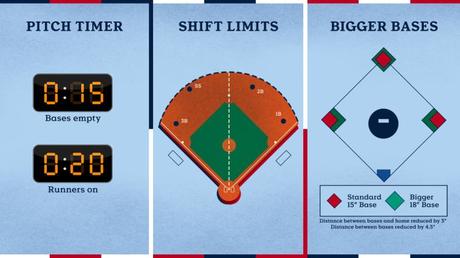There’s been a lot of talk about the new rules going into effect for Major League Baseball’s 2023 season. With Opening Day just over a month away, it seems like a good time to take a look at these updates here.
 mlb.com
mlb.com
Bigger bases
This year, the size of first base, second base, and third base is increasing from 15 inches to 18 inches square. This, in effect, decreases the distance between bases by 4.5 inches. One argument in favor of this change is that it will create more excitement, with closer plays at each base. The league believes that the larger bases will also decrease injuries, which seems like a more plausible explanation.
My thoughts: I can’t help but wonder how necessary this really is. I have heard the new bases getting compared to pizza boxes, which seems a bit excessive to me. When I played softball in high school, there was a “safety base” at first base — a double base that allowed the runner to run through the exterior base while the first baseman fielded the throw from the interior base. I think I would rather see the double base implemented at first over the bigger bases all around the infield. Is there a greater injury risk with the smaller bases? Sure, I agree that’s probably true. I guess I’m opposed to this change in the same way I oppose the restriction on sliding into fielders to break up a double play. It takes away from the game, in a way.
On the other hand, some proponents point out this could mean an increase in stolen bases. As a fan of small ball, if this turns out to be true and the game becomes more exciting as a result, I might become a convert.
Restrictions on defensive shifts
Going forward, we will no longer see defensive shifts where the shortstop or the third baseman plays on the first base side of second base. With the new restrictions, two infielders are required to remain positioned on each side of second base. Furthermore, infielders must have both feet situated within the boundaries of the infield — no more second basemen playing shallow right field. What’s more, players cannot switch positions unless a substitution is made. Therefore, a team’s second baseman and shortstop must stay in their positions — they are not interchangeable for the sake of putting the better defender in position to field a batted ball.
My thoughts: At first, I was very much against this. In his book, The Science of Hitting, Ted Williams argues that it is up to the batter to adjust to the shift, and that made perfect sense to me. But then I saw this tweet about the decline of batting averages in recent years, and I realize that perhaps the shift has become a little too effective, and maybe it is time to bring a little bit of a spark back to small ball.
The pitch clock
In the same way that basketball has a shot clock and football has a play clock, baseball now has a pitch clock. Between batters, the pitch clock is set to 30 seconds before the pitcher must begin his motion. When bases are empty, the clock sets a limit of 15 seconds between pitches. When runners are on base, this limit is 20 seconds. If there is a delay that is determined to be the pitcher’s fault, a ball is added to the batter’s count. If umpires determine a delay is the batter’s fault, then a strike is added to the count.
The rule also limits hitters to one timeout per plate appearance and allows pitchers to step off the rubber twice per plate appearance, at which point the clock resets. This essentially puts a limit on the number of pickoff attempts a pitcher can make, which will hinder pitchers’ ability to prevent stolen bases. You’re able to make a third pickoff attempt, but if you don’t get the runner out, it’s a balk, and the runner advances automatically.
My thoughts: I am a bigger fan of this change than I thought I would be. As much as I love baseball, even I can find the 3 1/2-hour games a bit cumbersome. Maybe that’s just my millennial attention span speaking, but I don’t think so. Back in the day, baseball games were played in as little as 51 minutes. Granted, a lot of the delay in today’s games are due to commercials, ballpark entertainment, and other advertising bull, but I do think that it is a good time to inject a little pickup into the pace of the game itself.

